Abstract
SMEDI and hog cholera viruses were shown to have marked effects upon the survival of the embryo (from conception to 30 days of gestation), the fetus (from 30 days of gestation until birth), and the neonatal pig (from birth until five days after birth). Embryonic infection was characterized by death and absorption of the embryo and in some instances the return to estrus after an irregular estrous cycle. Embryonic infection also may have been responsible for the development of some abnormal pigs. Fetal infection caused death with mummification of one or more fetuses and occasionally all fetuses in the uterus. Infection established in early gestation produced effects on the fetus which apparently persisted until after birth and varied from a persistent viremia (as in hog cholera infection) to an undefined lack of resistance in the newborn (as in SMEDI virus infection). Hog cholera vaccinal virus was the more virulent of the two virus types and reacted somewhat like rubella virus, in that infection apparently could be established in the fetus even in middle trimester of pregnancy, and possibly later. SMEDI viruses, in contrast, were less virulent and were most pathogenic when the dam was infected during the first 30 days of pregnancy. Immunity against either virus could be established in the nonpregnant gilt and was most effective in preventing intrauterine infections with that virus. However, with as many as 10 enteroviruses (five are known to cause intrauterine infection) it was believed that maintaining a closed breeding herd and introducing new stock into contact with the breeding herd at least 30 days before breeding time might be a safer means of control.
Full text
PDF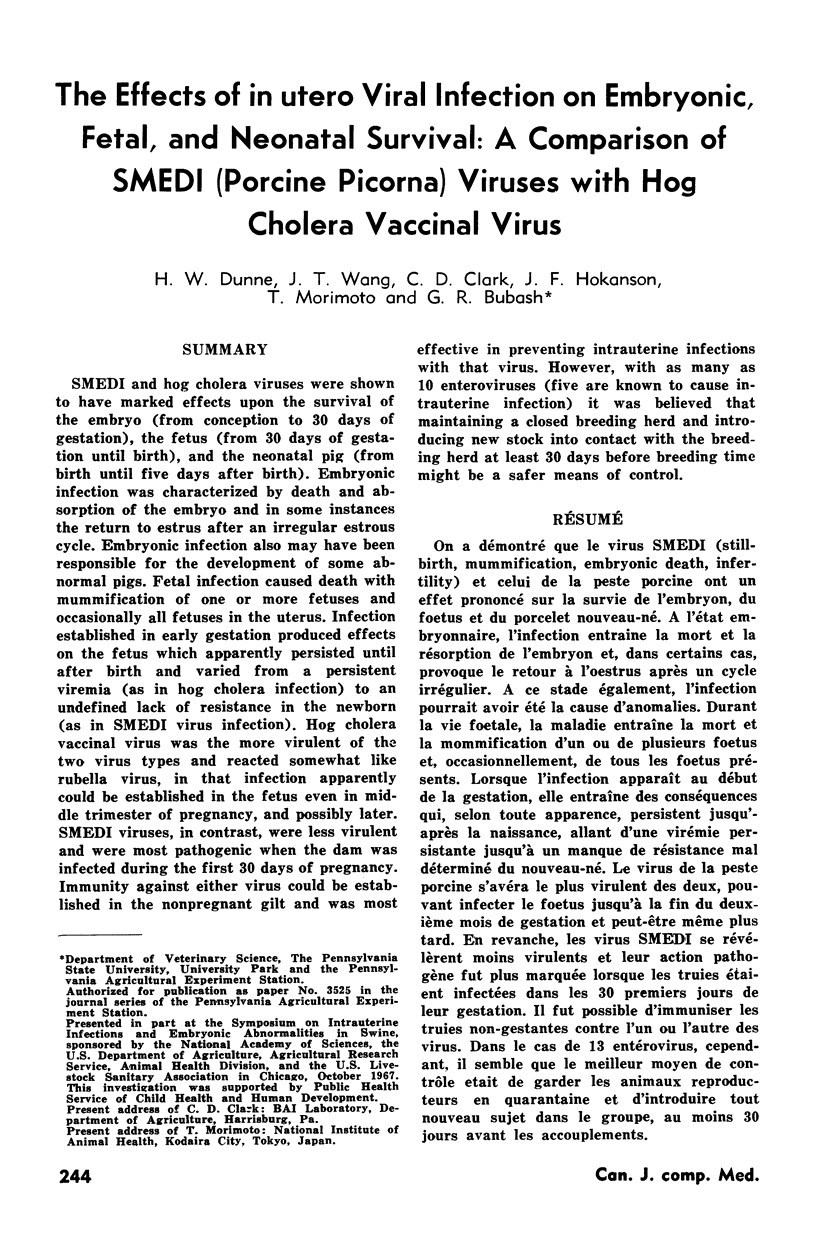
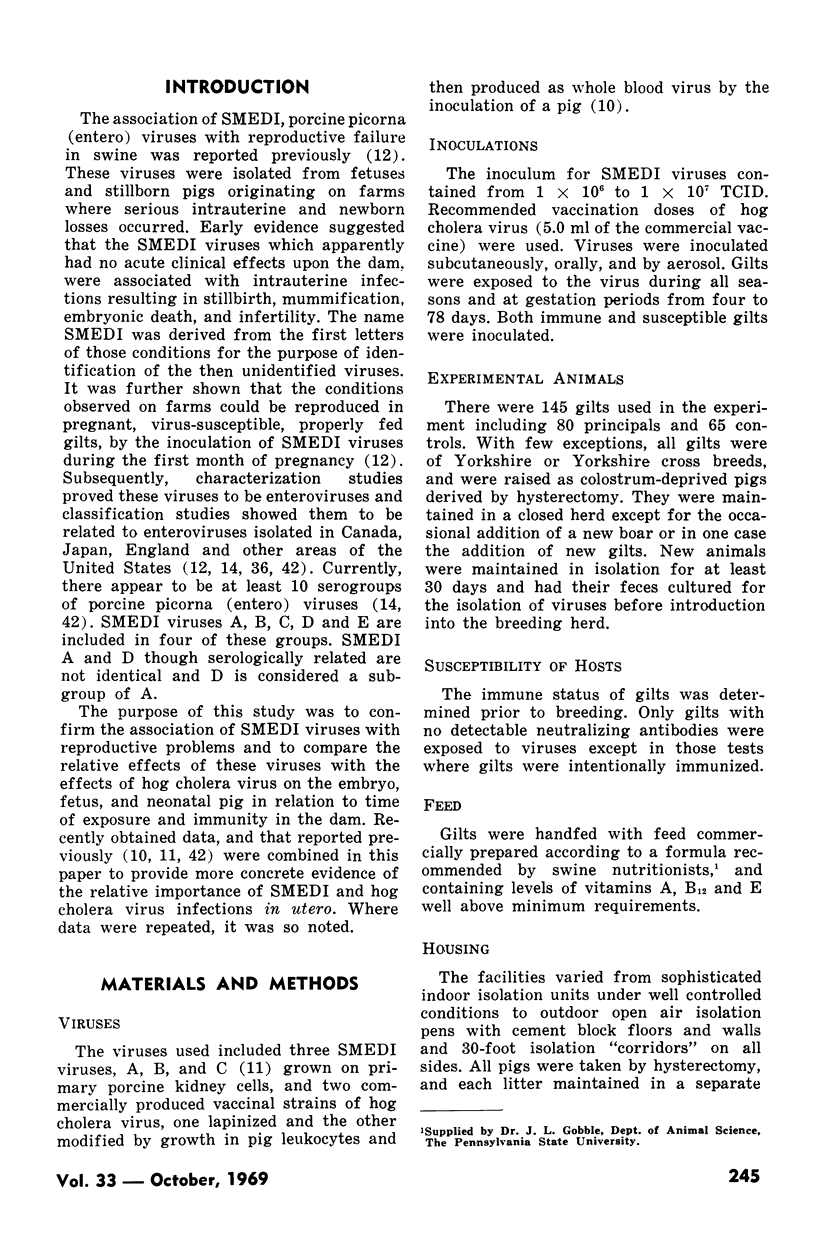
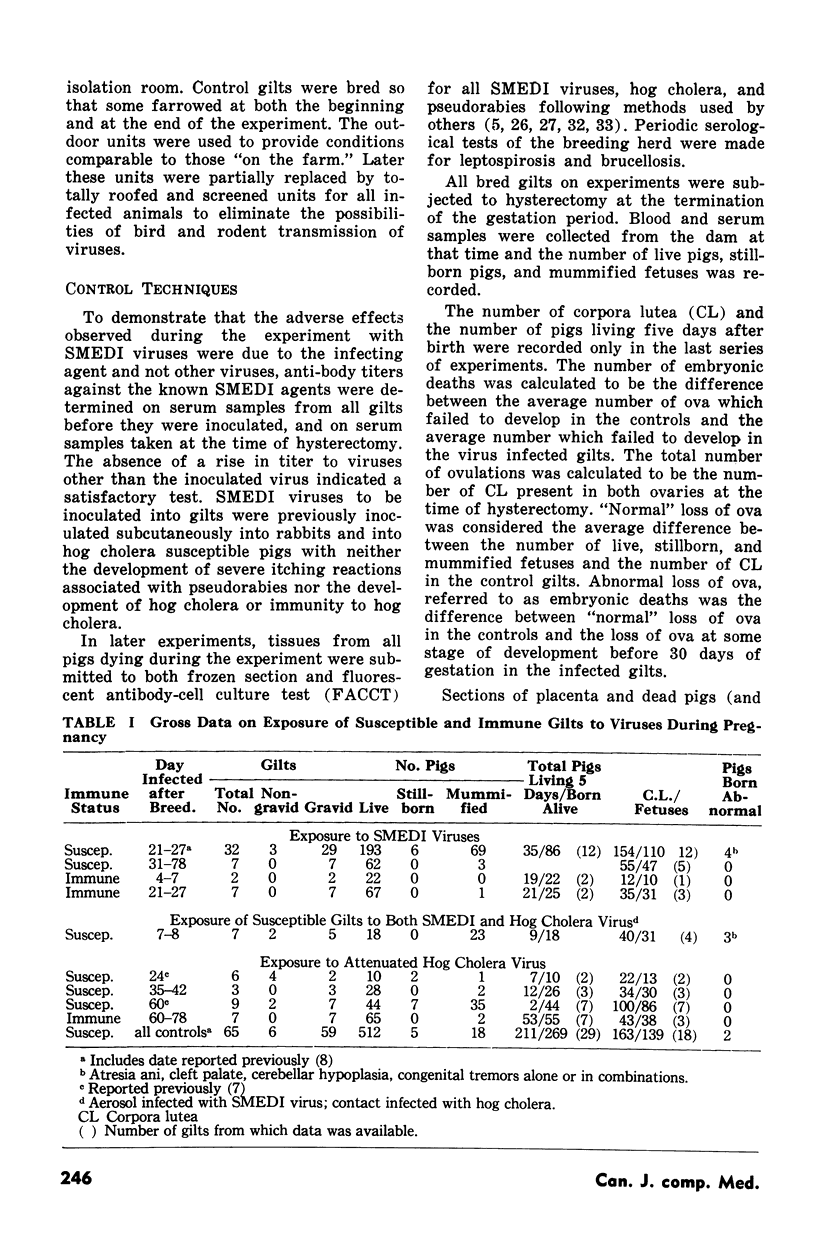
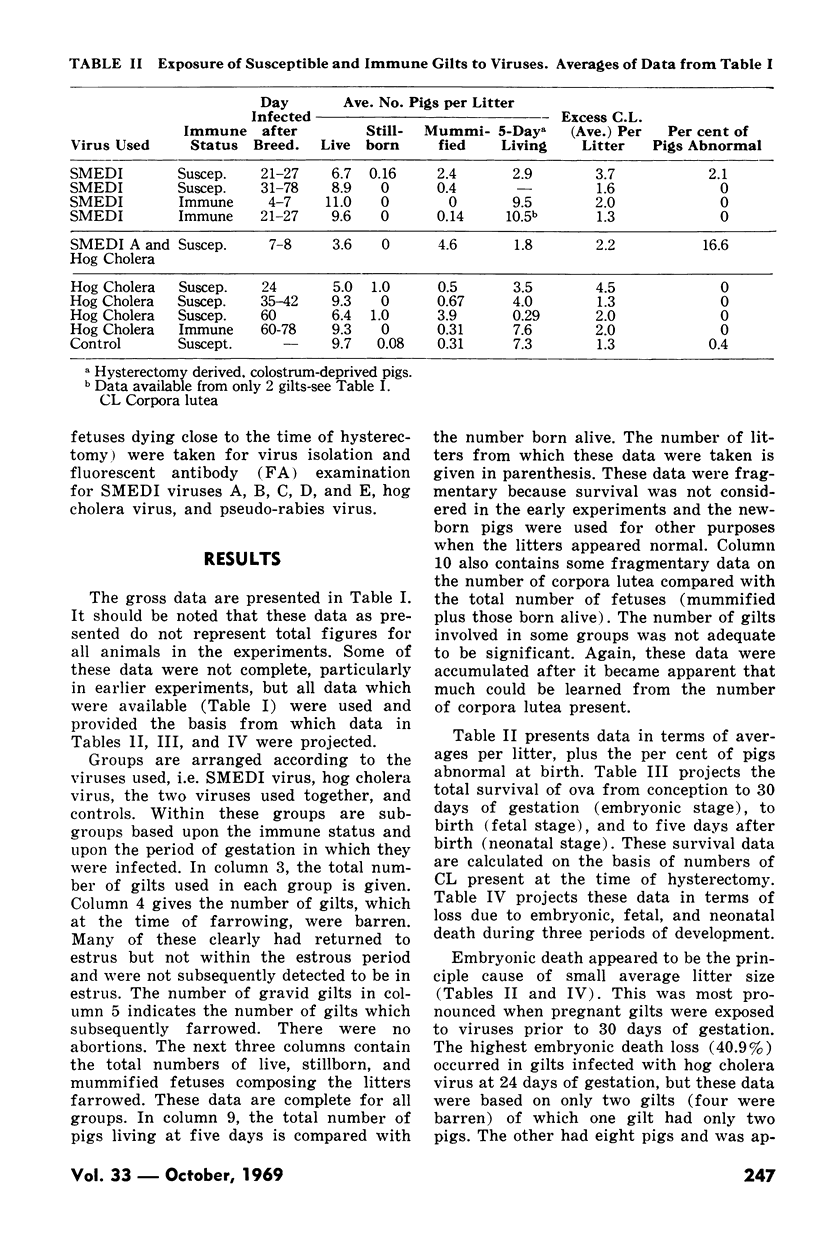
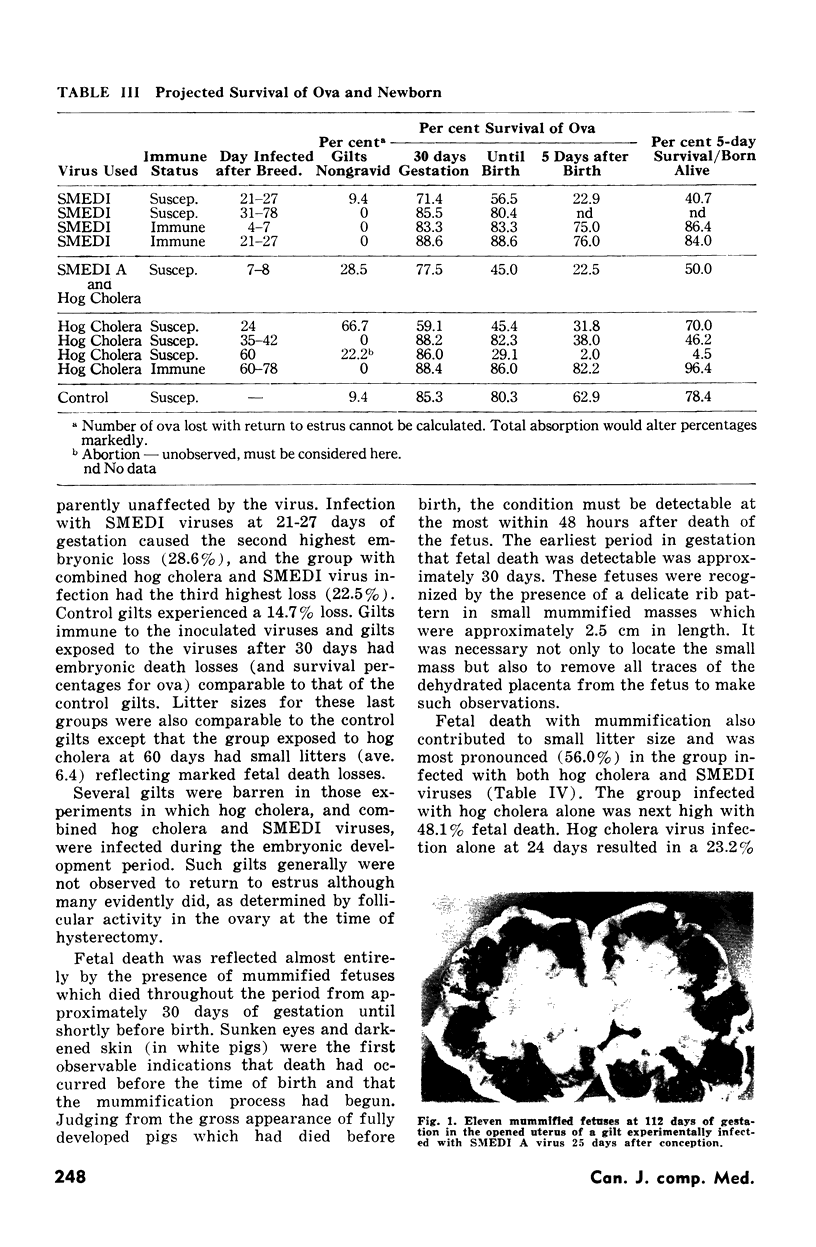
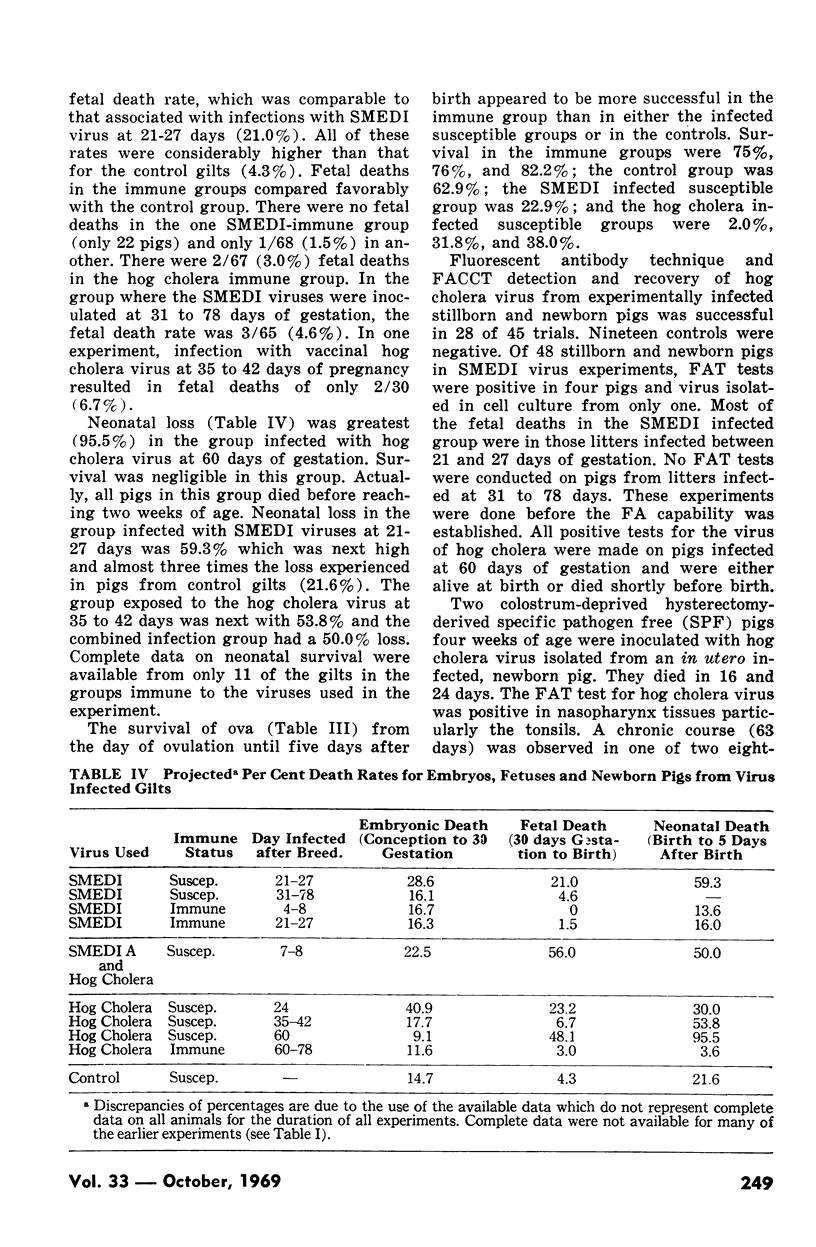

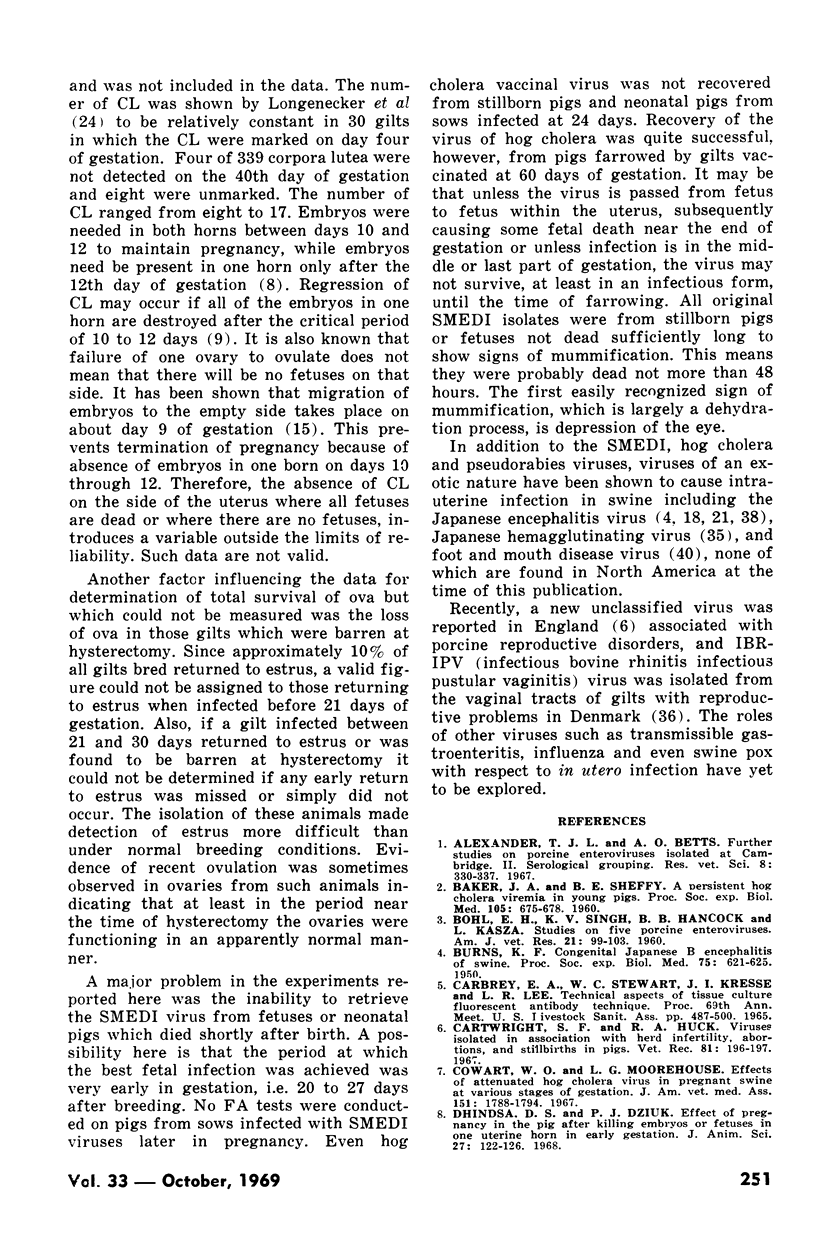
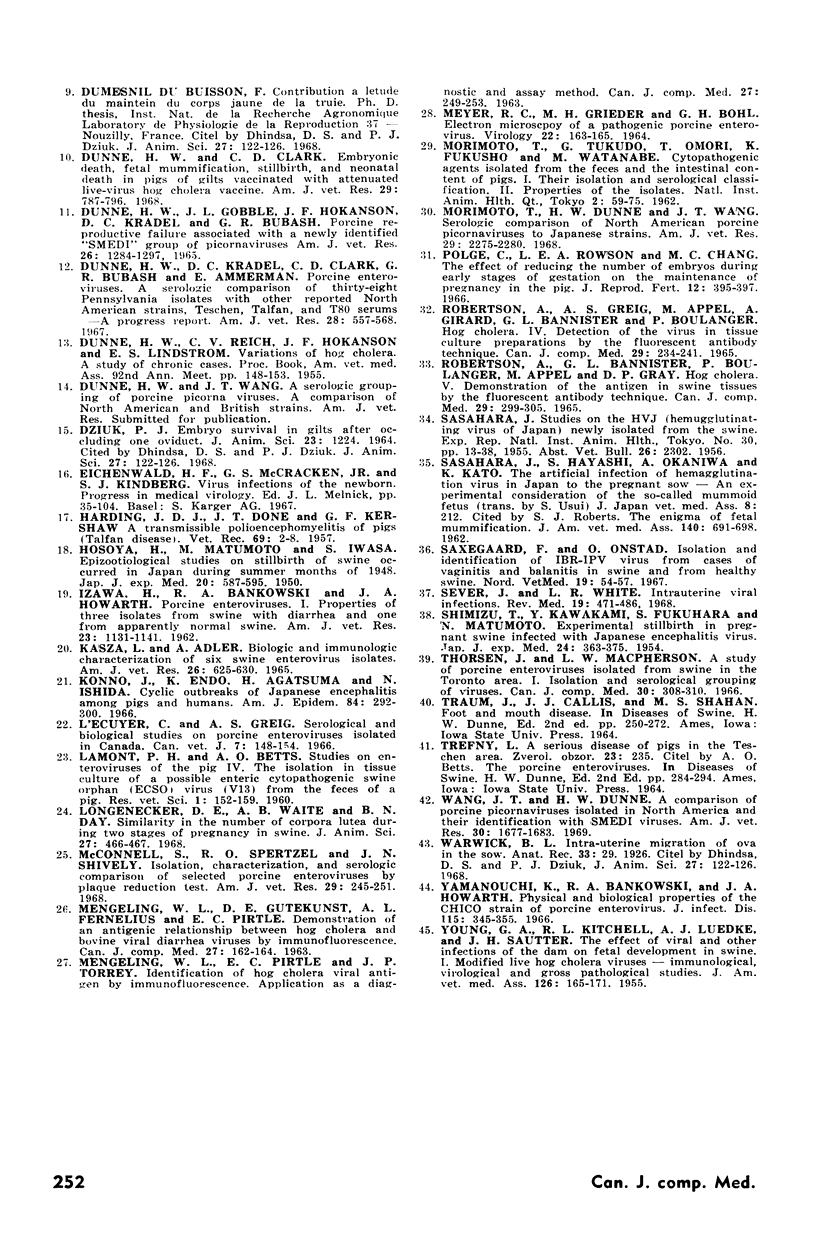
Images in this article
Selected References
These references are in PubMed. This may not be the complete list of references from this article.
- Alexander T. J., Betts A. O. Further studies on porcine enteroviruses isolated at Cambridge. II. Serological grouping. Res Vet Sci. 1967 Jul;8(3):330–337. [PubMed] [Google Scholar]
- BAKER J. A., SHEFFY B. E. A persistent hog cholera viremia in young pigs. Proc Soc Exp Biol Med. 1960 Dec;105:675–678. doi: 10.3181/00379727-105-26214. [DOI] [PubMed] [Google Scholar]
- BOHL E. H., SINGH K. V., HANCOCK B. B., KASZA L. Studies on five porcine enteroviruses. Am J Vet Res. 1960 Jan;21:99–103. [PubMed] [Google Scholar]
- BURNS K. F. Congenital Japanese B encephalitis infection of swine. Proc Soc Exp Biol Med. 1950 Nov;75(2):621–625. doi: 10.3181/00379727-75-18285. [DOI] [PubMed] [Google Scholar]
- Dhindsa D. S., Dziuk P. J. Effect on pregnancy in the pig after killing embryos or fetuses in one uterine horn in early gestation. J Anim Sci. 1968 Jan;27(1):122–126. doi: 10.2527/jas1968.271122x. [DOI] [PubMed] [Google Scholar]
- Dhindsa D. S., Dziuk P. J. Effect on pregnancy in the pig after killing embryos or fetuses in one uterine horn in early gestation. J Anim Sci. 1968 Jan;27(1):122–126. doi: 10.2527/jas1968.271122x. [DOI] [PubMed] [Google Scholar]
- Dhindsa D. S., Dziuk P. J. Effect on pregnancy in the pig after killing embryos or fetuses in one uterine horn in early gestation. J Anim Sci. 1968 Jan;27(1):122–126. doi: 10.2527/jas1968.271122x. [DOI] [PubMed] [Google Scholar]
- Dunne H. W., Clark C. D. Embryonic death, fetal mummification, stillbirth, and neonatal death in pigs of gilts vaccinated with attenuated live-virus hog cholera vaccine. Am J Vet Res. 1968 Apr;29(4):787–796. [PubMed] [Google Scholar]
- Dunne H. W., Gobble J. L., Hokanson J. F., Kradel D. C., Bubash G. R. Porcine reproductive failure associated with a newly identified "SMEDI" group of picorna viruses. Am J Vet Res. 1965 Nov;26(115):1284–1297. [PubMed] [Google Scholar]
- IZAWA H., BANKOWSKI R. A., HOWARTH J. A. Porcine enteroviruses. I. Properties of three isolates from swine with diarrhea and one from apparently normal swine. Am J Vet Res. 1962 Nov;23:1131–1141. [PubMed] [Google Scholar]
- KASZA L., ADLER A. BIOLOGIC AND IMMUNOLOGIC CHARACTERIZATION OF 6 SWINE ENTEROVIRUS ISOLATES. Am J Vet Res. 1965 May;26:625–630. [PubMed] [Google Scholar]
- Konno J., Endo K., Agatsuma H., Ishida N. Cyclic outbreaks of Japanese encephalitis among pigs and humans. Am J Epidemiol. 1966 Sep;84(2):292–300. doi: 10.1093/oxfordjournals.aje.a120643. [DOI] [PubMed] [Google Scholar]
- L'Ecuyer C., Greig A. S. Serological and biological studies on porcine enteroviruses isolated in Canada. Can Vet J. 1966 Jul;7(7):148–154. [PMC free article] [PubMed] [Google Scholar]
- Longenecker D. E., Waite A. B., Day B. N. Similarity in the number of corpora lutea during two stages of pregnancy in swine. J Anim Sci. 1968 Mar;27(2):466–467. doi: 10.2527/jas1968.272466x. [DOI] [PubMed] [Google Scholar]
- Mengeling W. L., Gutekunst D. E., Fernelius A. L., Pirtle E. C. Demonstration of an Antigenic Relationship Between Hog Cholera and Bovine Viral Diarrhea Viruses by Immunofluorescence. Can J Comp Med Vet Sci. 1963 Jul;27(7):162–164. [PMC free article] [PubMed] [Google Scholar]
- Mengeling W. L., Pirtle E. C., Torrey J. P. Identification of Hog Cholera Viral Antigen by Immunofluorescence. Application as a Diagnostic and Assay Method. Can J Comp Med Vet Sci. 1963 Oct;27(10):249–252. [PMC free article] [PubMed] [Google Scholar]
- Morimoto T., Dunne H. W., Wang J. T. Serologic comparison of North American and Japanese porcine picornaviruses. Am J Vet Res. 1968 Dec;29(12):2275–2280. [PubMed] [Google Scholar]
- Polge C., Rowson L. E., Chang M. C. The effect of reducing the number of embryos during early stages of gestation on the maintenance of pregnancy in the pig. J Reprod Fertil. 1966 Oct;12(2):395–397. doi: 10.1530/jrf.0.0120395. [DOI] [PubMed] [Google Scholar]
- ROBERTS S. J. The enigma of fetal mummification. J Am Vet Med Assoc. 1962 Apr 1;140:691–698. [PubMed] [Google Scholar]
- Robertson A., Bannister G. L., Boulanger P., Appel M., Gray D. P. Hog cholera. V. Demonstration of the antigen in swine tissues by the fluorescent antibody technique. Can J Comp Med Vet Sci. 1965 Dec;29(12):299–305. [PMC free article] [PubMed] [Google Scholar]
- Robertson A., Greig A. S., Appel M., Girard A., Bannister G. L., Boulanger P. Hog cholera IV. Detection of the virus in tissue culture preparations by the fluorescent antibody technique. Can J Comp Med Vet Sci. 1965 Sep;29(9):234–241. [PMC free article] [PubMed] [Google Scholar]
- SHIMIZU T., KAWAKAMI Y., FUKUHARA S., MATUMOTO M. Experimental stillbirth in pregnant swine infected with Japanese encephalitis virus. Jpn J Exp Med. 1954 Dec;24(6):363–375. [PubMed] [Google Scholar]
- Sever J., White L. R. Intrauterine viral infections. Annu Rev Med. 1968;19:471–486. doi: 10.1146/annurev.me.19.020168.002351. [DOI] [PubMed] [Google Scholar]
- Thorsen J., Macpherson L. W. A study of procine enteroviruses isolated from swine in the Toronto area. I. Isolation and serological grouping of viruses. Can J Comp Med Vet Sci. 1966 Nov;30(11):308–310. [PMC free article] [PubMed] [Google Scholar]
- Wang J. T., Dunne H. W. Comparison of porcine picornaviruses isolated in North America and their identification with SMEDI viruses. Am J Vet Res. 1969 Sep;30(9):1677–1683. [PubMed] [Google Scholar]
- YOUNG G. A., KITCHELL R. L., LUEDKE A. J., SAUTTER J. H. The effect of viral and other infections of the dam on fetal development in swine. I. Modified live hog cholera viruses; immunological, virological, and gross pathological studies. J Am Vet Med Assoc. 1955 Mar;126(936):165–171. [PubMed] [Google Scholar]
- Yamanouchi K., Bankowski R. A., Howarth J. A. Physical and biological properties of the Chico strain of porcine enterovirus. J Infect Dis. 1965 Oct;115(4):345–355. doi: 10.1093/infdis/115.4.345. [DOI] [PubMed] [Google Scholar]



